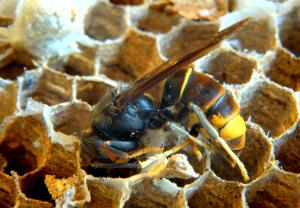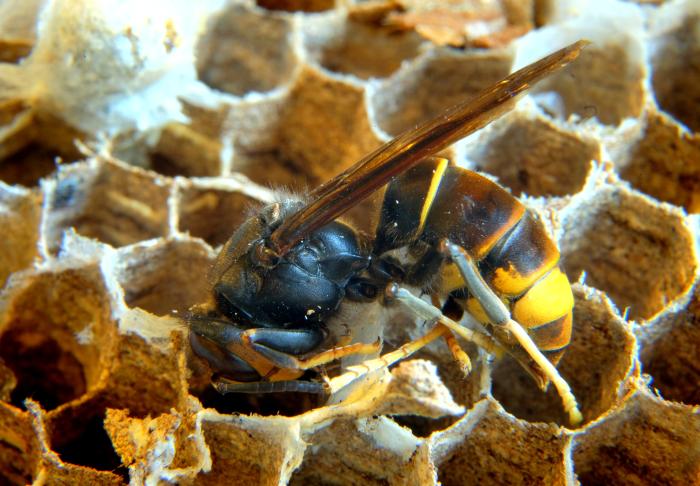Category: Nature Photography
Post Type:
Photography
Mixed Media: None | major cropping
Pays
one point
and 2 member cents.





© Copyright 2025. supergold All rights reserved.
supergold has granted FanStory.com, its affiliates and its syndicates non-exclusive rights to display this work.
Posted: December 1, 2015
      |
Asian predatory wasp
Asian hornet
by supergold
Interested in this? Contact The Artist
You can own this. Offers accepted. Information
The Asian predatory wasp, also known as the Asian Hornet or yellow-legged hornet, (Vespa velutina) is a species of hornet indigenous to Southeast Asia. It is of concern as an invasive species in some other countries.
Vespa velutina is slightly smaller than the European hornet. Typically queens are 30 mm in length, and males about 24 mm. Workers measure about 20 mm
in length. The species has distinctive yellow tarsi. The thorax is a velvety brown or black with a brown abdomen. Each abdominal segment has a narrow posterior yellow border, except for the fourth segment, which is orange. The head is black and the face yellow. Regional forms vary sufficiently in colour to cause difficulties in classification, and several subspecies have been variously identified or rejected. The form that is causing concern about its invasiveness in Europe is Vespa velutina nigrithorax.
Like other hornets, Vespa velutina builds nests that may house colonies of several thousand individuals. Females in the colony are armed with formidable stingers with which they defend their nests and kill their prey. The nest is of paper, roughly in the shape of a prolate spheroid with a vertical long axis. It commonly grows very large, more than half a metre in length.
Vespa velutina opportunistically hunts a very wide range of insects, including flies, dragonflies and Orthoptera, typically capturing them by pursuit.[2] The major concern about their invasiveness however, is that when they find a bee colony or an apiary, they tend to settle down and specialise in honeybees as their prey.
Vespa velutina has become an invasive species in France where it is believed to have arrived in boxes of pottery from China in 2004. Humans have been attacked after disturbing hornets; although the species is not aggressive it "charges in a group as soon as it feels its nest is threatened". People have been hospitalised in France after suffering anaphylactic shock as a result of multiple stings. Because of hornets' larger size, their sting is more serious than that of a bee. By 2009 there were several thousand nests in the area of Bordeaux and surrounding departments
by supergold Interested in this? Contact The Artist
Mixed Media: None | major cropping


Asian hornet
by supergold

You need to login or register to write reviews. It's quick! We only ask four questions to new members.
© Copyright 2025. supergold All rights reserved.
supergold has granted FanStory.com, its affiliates and its syndicates non-exclusive rights to display this work.

